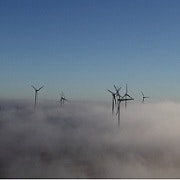Wind sector battle heats up
European and Chinese wind turbine makers are poised to do battle away from their domestic markets as the focus in the €60 billion euro ($A85 billion) industry shifts to North America, Brazil and India.
Hit by overcapacity and plunging prices in Europe and China's saturated markets, manufacturers of wind turbines are under pressure to find new areas of growth to boost single-digit profit margins.
Clashes between the two factions have been limited so far. Chinese companies were busy with a boom in a home market that is resistant to overseas interlopers, while European companies cemented a position of strength in their markets.
Long-established quality and brand recognition has also enabled the Europeans to establish a respectable foothold in foreign markets, including the United States, where General Electric will fight hard to defend its leadership.
However, a 26 per cent decline in new turbine installations in China last year – triggered by overcapacity, lack of finance and grid connection issues – has upped the ante for Chinese businesses to improve quality and services to take on European rivals abroad.
"I expect to see the big Chinese players gain market share in international markets over time," said Steen Broust Nielsen, partner at Denmark-based MAKE Consulting.
The concern about competition from the east is partly based on developments in the solar sector in recent years, where Chinese players edged out many European peers in the global market for solar panels.
Frankfurt-based Union Investment fund manager Thomas Deser played down the parallels, pointing out that turbines require far greater engineering expertise than solar panels because of their size and the external forces to which they are exposed.
"Wind turbines are no commodity," he said.
The global wind turbine market is largely controlled by western manufacturers. MAKE Consulting says that US group General Electric, Denmark's Vestas, Spain's Gamesa and Germany's Siemens and Enercon held a combined 55 per cent in 2012.
For now, the four Chinese companies among the top 10 – Goldwind, United Power, Sinovel and Ming Yang – share only 16 per cent.
Price vs quality
Chinese companies benefit from extensive economies of scale that allow them to price their turbines about a third cheaper than European equivalents. But inferior maintenance services and problems with fan blades, including instability and shorter lifespans, still separate them from their western peers.
"The Chinese are lacking the required service network," a spokesman for German wind turbine maker Nordex said, adding that some Nordex turbines include a unique anti-icing system that heats up parts of the blades when temperatures fall.
Industry analysts and executives agree that it is unlikely that the Chinese will attack their western peers in Europe, given the high shipping costs and the Europeans' superior maintenance services.
The big contest is more likely to occur in North America and emerging markets.
HSBC estimates that Canada, Brazil, Mexico and India will account for more than 18 per cent of the global market by 2015, compared with 11.5 per cent last year.
The US, meanwhile, could account for 17.4 per cent of the global market in 2014, up from an expected 6 per cent this year, after extending a tax credit break in January.
Some Chinese players have already made a move. Ming Yang, for instance, acquired a 50 per cent stake in India's Global Wind Power last year for $20 million to enter the Indian market and said it aims to expand further in major overseas markets.
Goldwind, China's top wind turbine manufacturer by sales, has said that fierce domestic competition is forcing it to push into international markets including Africa, South America, Australia and the United States. International markets accounted for 11.6 per cent of Goldwind's sales last year, up from 9.5 per cent in 2011.
Western players, however, continue to rely on their superior quality when it comes to new markets.
"You have to demonstrate the quality of your product," said Keith Longtin, general manager of wind products at General Electric. "I don't think, just because you're going to Brazil, customers are not going to want that."
-- Reuters.
















